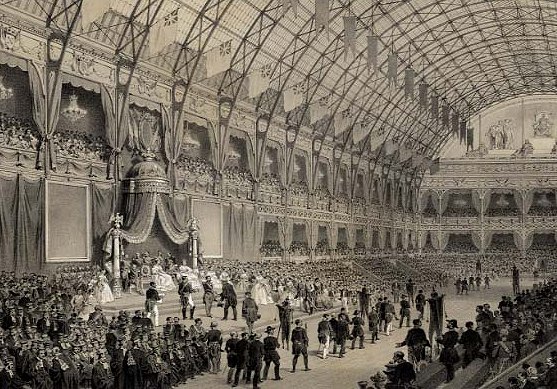Art in the Second Empire
Below you will find a description of the politics of art in the 1850s. As you read this passage from Patricia Mainardi's Art and Politics of the Second Empire (New Haven, Connecticut: Yale University Press, 1987), pp.33-47, pay attention to the importance that art had for this society and the ways in which the government felt that it needed to be involved in the arts.

Palace of Industry at the 1855 Universal Exposition
THE 1855 UNIVERSAL EXPOSITION marked both the end of one era and the beginning of another. Until the Second Republic, the world of art still clung to centuries-old tradition: artists of major importance, such as Ingres and Delacroix, were usually recognized by the Government and produced, on commission, large-scale history paintings for public consumption. Contemporary taste was defined by the Academy and by cultivated amateurs who played quasi-governmental roles in assuring that the King or Emperor had, or at least seemed to have, suitably elevated aesthetic judgment. By the end of the Second Empire, the modern art world had emerged. Henceforth, neither Church nor State, neither aristocracy nor Academy would be able to set the rules: a new power, the bourgeoisie, had emerged, demanding recognition of its own taste. And although modern scholars might dispute the def1nition of the bourgeoisie, nineteenth century art critics knew exactly whom they meant -- the untitled but well-to-do members of the manufacturing and commercial classes who bought pictures for investment and decoration and preferred the lower genres of art. If culture can be said to follow economics, then one might consider the Revolution of 1789, with its economic shift of power from the aristocracy to the bourgeoisie, as leading inexorably, almost a century later. to the aesthetic shift described here. The major art event of the 1850s was the Universal Exposition of 1855, as much a political as a cultural event. This study, then, should begin with a survey of the political protagonists in the French art world of the 1800s, for it was they, and not artists who set official standards of taste. |
|---|
Cast of Characters
Mainardi gives us descriptions of some of the people who had great influence over the arts. Below you will find a description of the inner workings of the art world of the Second Empire as it shaped the art at the 1855 exhibition. By clicking the names below you will short descriptions of some of the decision makers of the time who made decisions that helped shape what appeared in the Salon, and you can begin to form an idea of how the system worked: